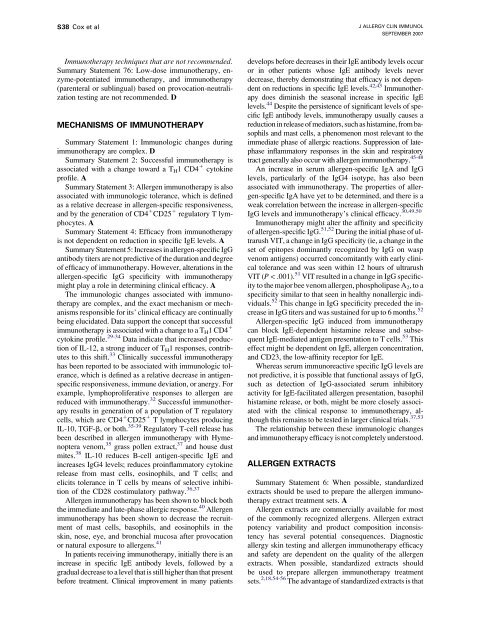Immunotherapy Safety for the Primary Care ... - U.S. Coast Guard
Immunotherapy Safety for the Primary Care ... - U.S. Coast Guard
Immunotherapy Safety for the Primary Care ... - U.S. Coast Guard
Create successful ePaper yourself
Turn your PDF publications into a flip-book with our unique Google optimized e-Paper software.
S38 Cox et al<br />
J ALLERGY CLIN IMMUNOL<br />
SEPTEMBER 2007<br />
<strong>Immuno<strong>the</strong>rapy</strong> techniques that are not recommended.<br />
Summary Statement 76: Low-dose immuno<strong>the</strong>rapy, enzyme-potentiated<br />
immuno<strong>the</strong>rapy, and immuno<strong>the</strong>rapy<br />
(parenteral or sublingual) based on provocation-neutralization<br />
testing are not recommended. D<br />
MECHANISMS OF IMMUNOTHERAPY<br />
Summary Statement 1: Immunologic changes during<br />
immuno<strong>the</strong>rapy are complex. D<br />
Summary Statement 2: Successful immuno<strong>the</strong>rapy is<br />
associated with a change toward a T H 1 CD4 1 cytokine<br />
profile. A<br />
Summary Statement 3: Allergen immuno<strong>the</strong>rapy is also<br />
associated with immunologic tolerance, which is defined<br />
as a relative decrease in allergen-specific responsiveness,<br />
and by <strong>the</strong> generation of CD4 1 CD25 1 regulatory T lymphocytes.<br />
A<br />
Summary Statement 4: Efficacy from immuno<strong>the</strong>rapy<br />
is not dependent on reduction in specific IgE levels. A<br />
Summary Statement 5: Increases in allergen-specific IgG<br />
antibody titers are not predictive of <strong>the</strong> duration and degree<br />
of efficacy of immuno<strong>the</strong>rapy. However, alterations in <strong>the</strong><br />
allergen-specific IgG specificity with immuno<strong>the</strong>rapy<br />
might play a role in determining clinical efficacy. A<br />
The immunologic changes associated with immuno<strong>the</strong>rapy<br />
are complex, and <strong>the</strong> exact mechanism or mechanisms<br />
responsible <strong>for</strong> its’ clinical efficacy are continually<br />
being elucidated. Data support <strong>the</strong> concept that successful<br />
immuno<strong>the</strong>rapy is associated with a change to a T H 1CD4 1<br />
cytokine profile. 29-34 Data indicate that increased production<br />
of IL-12, a strong inducer of T H 1 responses, contributes<br />
to this shift. 33 Clinically successful immuno<strong>the</strong>rapy<br />
has been reported to be associated with immunologic tolerance,<br />
which is defined as a relative decrease in antigenspecific<br />
responsiveness, immune deviation, or anergy. For<br />
example, lymphoproliferative responses to allergen are<br />
reduced with immuno<strong>the</strong>rapy. 32 Successful immuno<strong>the</strong>rapy<br />
results in generation of a population of T regulatory<br />
cells, which are CD4 1 CD25 1 T lymphocytes producing<br />
IL-10, TGF-b, or both. 35-39 Regulatory T-cell release has<br />
been described in allergen immuno<strong>the</strong>rapy with Hymenoptera<br />
venom, 35 grass pollen extract, 37 and house dust<br />
mites. 38 IL-10 reduces B-cell antigen-specific IgE and<br />
increases IgG4 levels; reduces proinflammatory cytokine<br />
release from mast cells, eosinophils, and T cells; and<br />
elicits tolerance in T cells by means of selective inhibition<br />
of <strong>the</strong> CD28 costimulatory pathway. 36,37<br />
Allergen immuno<strong>the</strong>rapy has been shown to block both<br />
<strong>the</strong> immediate and late-phase allergic response. 40 Allergen<br />
immuno<strong>the</strong>rapy has been shown to decrease <strong>the</strong> recruitment<br />
of mast cells, basophils, and eosinophils in <strong>the</strong><br />
skin, nose, eye, and bronchial mucosa after provocation<br />
or natural exposure to allergens. 41<br />
In patients receiving immuno<strong>the</strong>rapy, initially <strong>the</strong>re is an<br />
increase in specific IgE antibody levels, followed by a<br />
gradual decrease to a level that is still higher than that present<br />
be<strong>for</strong>e treatment. Clinical improvement in many patients<br />
develops be<strong>for</strong>e decreases in <strong>the</strong>ir IgE antibody levels occur<br />
or in o<strong>the</strong>r patients whose IgE antibody levels never<br />
decrease, <strong>the</strong>reby demonstrating that efficacy is not dependent<br />
on reductions in specific IgE levels. 42,43 <strong>Immuno<strong>the</strong>rapy</strong><br />
does diminish <strong>the</strong> seasonal increase in specific IgE<br />
levels. 44 Despite <strong>the</strong> persistence of significant levels of specific<br />
IgE antibody levels, immuno<strong>the</strong>rapy usually causes a<br />
reduction in release of mediators, such as histamine, from basophils<br />
and mast cells, a phenomenon most relevant to <strong>the</strong><br />
immediate phase of allergic reactions. Suppression of latephase<br />
inflammatory responses in <strong>the</strong> skin and respiratory<br />
tract generally also occur with allergen immuno<strong>the</strong>rapy. 45-48<br />
An increase in serum allergen-specific IgA and IgG<br />
levels, particularly of <strong>the</strong> IgG4 isotype, has also been<br />
associated with immuno<strong>the</strong>rapy. The properties of allergen-specific<br />
IgA have yet to be determined, and <strong>the</strong>re is a<br />
weak correlation between <strong>the</strong> increase in allergen-specific<br />
IgG levels and immuno<strong>the</strong>rapy’s clinical efficacy. 30,49,50<br />
<strong>Immuno<strong>the</strong>rapy</strong> might alter <strong>the</strong> affinity and specificity<br />
of allergen-specific IgG. 51,52 During <strong>the</strong> initial phase of ultrarush<br />
VIT, a change in IgG specificity (ie, a change in <strong>the</strong><br />
set of epitopes dominantly recognized by IgG on wasp<br />
venom antigens) occurred concomitantly with early clinical<br />
tolerance and was seen within 12 hours of ultrarush<br />
VIT (P
















